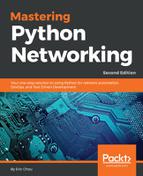The eAPI agent on the Arista device is disabled by default, so we will need to enable it on the device before we can use it:
arista1(config)#management api http-commands
arista1(config-mgmt-api-http-cmds)#no shut
arista1(config-mgmt-api-http-cmds)#protocol https port 443
arista1(config-mgmt-api-http-cmds)#no protocol http
arista1(config-mgmt-api-http-cmds)#vrf management
As you can see, we have turned off the HTTP server and are using HTTPS as the sole transport instead. Starting from a few EOS versions ago, the management interfaces, by default, reside in a VRF called management. In my topology, I am accessing the device via the management interface; therefore, I have specified the VRF for eAPI management. You can check that API management state via the "show management api http-commands" command:
arista1#sh management api http-commands
Enabled: Yes
HTTPS server: running, set to use port 443
HTTP server: shutdown, set to use port 80
Local HTTP server: shutdown, no authentication, set to use port 8080
Unix Socket server: shutdown, no authentication
VRF: management
Hits: 64
Last hit: 33 seconds ago
Bytes in: 8250
Bytes out: 29862
Requests: 23
Commands: 42
Duration: 7.086 seconds
SSL Profile: none
QoS DSCP: 0
User Requests Bytes in Bytes out Last hit
----------- -------------- -------------- --------------- --------------
admin 23 8250 29862 33 seconds ago
URLs
-----------------------------------------
Management1 : https://192.168.199.158:443
arista1#
After enabling the agent, you will be able to access the exploration page for eAPI by going to the device's IP address. If you have changed the default port for access, just append it at the end. The authentication is tied into the method of authentication on the switch. We will use the username and password configured locally on the device. By default, a self-signed certificate will be used:

You will be taken to an explorer page where you can type in the CLI command and get a nice output for the body of your request. For example, if I want to see how to make a request body for show version, this is the output I will see from the explorer:

The overview link will take you to the sample use and background information while the command documentation will serve as reference points for the show commands. Each of the command references will contain the returned value field name, type, and a brief description. The online reference scripts from Arista use jsonrpclib (https://github.com/joshmarshall/jsonrpclib/), which is what we will use. However, as of the time of writing this book, it has a dependency of Python 2.6+ and has not yet ported to Python 3; therefore, we will use Python 2.7 for these examples.
Installation is straightforward using easy_install or pip:
$ sudo easy_install jsonrpclib
$ sudo pip install jsonrpclib
